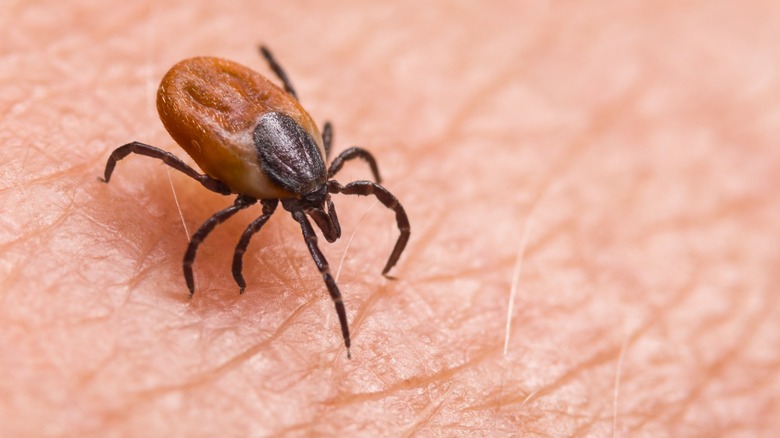How To Remove A Tick Without Tweezers
If you find a tick on your skin, while you understandably might fear that you're now at risk of becoming infected with a disease, not all ticks are harmful. In fact, the experts at Healthline note that tick bites are benign the majority of the time and don't cause symptoms. However, since ticks are blood-sucking parasites and you won't be able to tell if the tick you discover on your skin is the safe kind or the dangerous kind, you'll want to remove that little pest ASAP.
Ticks are often mistakenly thought of as insects, but, like spiders, they are actually arachnids. Ranging from brownish to black in color, ticks call trees, grass, and shrubs home and can be as small as a pinhead or as big as a pencil eraser. Though, when they gorge themselves on your blood after burrowing into a warm and moist spot on your body — such as your armpit, the back of your knees, or your scalp — some can grow as large as a marble, per Healthline.
Perhaps the most well-known disease spread from ticks to humans and animals is Lyme disease, caused by a bacteria called Borrelia burgdorferi via an infected deer tick. It is typically the infectious bite of the tiny, immature nymph-stage deer tick that causes Lyme disease after the tick has been attached to the host for around 36 to 48 hours or more. Adult ticks can also transmit Lyme disease, but since they are larger they are easier to detect and remove, per the Centers for Disease Control and Prevention.
Ways experts say you can safely remove ticks
According to the experts at Cleveland Clinic, Lyme disease can cause temporary facial paralysis and lead to serious, long-term neurological consequences. So it's vital to remove ticks promptly and correctly.
While a pair of tweezers is a common tool for tick removal, you may not have a pair handy. However, not to fear, there are other methods you can employ. For instance, the mosquito control experts at MosquitoNix say dental floss or a thin piece of thread or string can do the trick. Be sure to get the dental floss or thread as close to your skin as possible and make a tight loop around the head of the tick. Then firmly pull up on the thread or floss, being careful not to break the tick's head from its body to avoid leaving the tick's mouth in your skin.
Absent of tweezers or floss, you may also be able to remove a tick using liquid soap and a cotton ball or swab. Add a dab of soap to the ball or swab and hold it on the tick. The soap induces the tick to lift its head, entangling it in the cotton's fibers, which should enable you to dislodge the tick when you pull the ball or swab away, per MosquitoNix.
To prevent tick bites in the first place — especially in wooded areas — experts advise wearing a hat, tucking pant legs into socks, and staying at the center of paths to avoid trees, per Cleveland Clinic.

